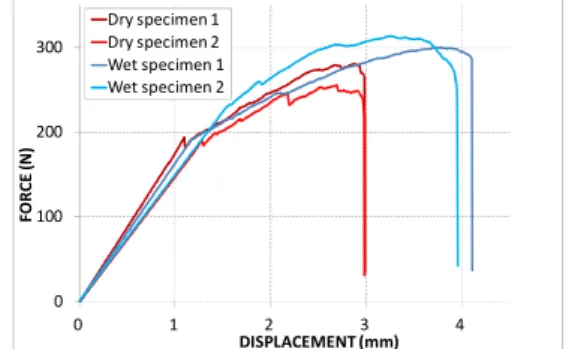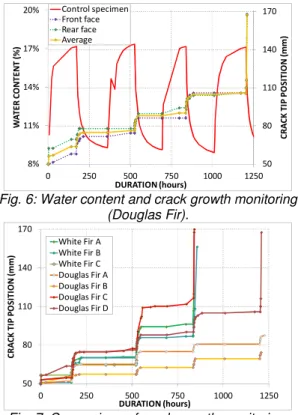First International Conference on Bio-based Building Materials
June 22nd - 24th 2015
Clermont-Ferrand, France
427
FRACTURE ANALYSIS OF WOOD UNDER VARIABLE ENVIRONMENT
N. Angellier1*, R. Moutou Pitti2, F. Dubois1
1 Université de Limoges, GEMH GC&D, 19300, Egletons, France 2
Université Blaise Pascal, Institut Pascal, BP 20206, Clermont-Ferrand, France *Corresponding author; nicolas.angellier@unilim.fr
Abstract
The better knowledge of crack driving forces is very important in the assessment of the reliability of timber structures. This work is part of the CLIMBOIS project related to the effects of climatic and mechanical variations on the durability of timber structures. It deals with several fracture tests performed in climatic chamber on the cracking of specimens machined in Douglas and White Fir species. Opening mode crack growth is studied with adapted specimen’s geometry. Both static and creep tests are performed, in variable humidity environment, with specific experimental set ups. The evolutions crack lengths are posted versus time. Experimental results obtained offer better understanding of the fracture behavior under variable environment of the studied species.
Keywords:
wood, fracture tests, creep test, energy release rate, variable environment
1 INTRODUCTION
ANR JCJC2013 CLIMBOIS project dealing with « effects of climatic and mechanical variations on the durability of timber structures » [Moutou Pitti 2013] delivers first experimental results. They belong to the first task of the project on « fracture and viscoelastic behavior », and concerns experimental validation of analytical formalisms of fracture mechanics analytical and numerical modeling of fracture coupled with viscoelasticity [Riahi 2014]. This paper focuses on fracture tests conducted in GEMH laboratory.
2 CHARACTERIZATION STATIC TESTS IN CONSTANT HUMIDITY ENVIRONMENT
Fig. 1: Experimental device (Douglas Fir). To assess the critical fracture force and the energy release rate of both Douglas and White Fir species, opening mode crack tests are conducted using a Zwick device (with displacement imposed at 0.5mm/min) for Double Cantilever Beam specimens
with variable inertia at the temperature of 25°C and relative humidity of 40% and 90%. Fig. 1 shows the different steps of the test for a Douglas Fir specimen. The comparison of the force-displacement curves emphasizes differences between wet and dry specimens behavior: if initial rigidity (around 150N/mm) and critical force (around 210N) remain unchanged, the post fracture phase exhibits different displacements, maximal forces or rigidities. Fig 2 shows a superposition for With Fir specimens. The average critical force value is used as the external force for forthcoming creep tests.
The external work, the released energy and the dissipated fracture energy evolutions are then calculated, Fig. 3, and the energy release rate is deduced. For dry specimens values are around 310J/m² for Douglas Fir and 200J/m² for White Fir. For wet specimens, values are around 400 J/m² for Douglas Fir and around 330 J/m² for White Fir.
0 100 200 300 0 1 2 3 4 F O R C E ( N ) DISPLACEMENT (mm) Dry specimen 1 Dry specimen 2 Wet specimen 1 Wet specimen 2
Fig. 2: Force-displacement curves for wet and dry specimens (White Fir).
ICBBM 2015 428 0 200 400 600 0 100 200 300 0 1 2 3 E N E R G Y ( mJ ) F O R C E ( N ) DISPLACEMENT (mm) Force External work Released energy Dissipated fracture energy
Fig. 3: Example of result: force and energies vs. displacement (White Fir).
3 CREEP TESTS IN VARIABLE HUMIDITY ENVIRONMENT
In the experimental device, a creep bench into a climatic chamber providing hydric cycles between 40% and 90% RH at a constant temperature of 25°C, Fig .4, allows testing four DCB specimens for each specie together, Fig. 5.
Two supplementary control specimens are weighed regularly for monitoring the water content, Fig. 6. The initial load applied through lever arm enables to initiate cracking without exceeding the stability zone. The crack tip position is regularly measured on both sides of the specimens, Fig. 6. Crack propagation occurs at the beginning of each drying phase. The complete rupture of the test specimens occurs after 1 to 4 cycles, Fig. 7 30 50 70 90 22 24 26 28 0 250 500 750 1 000 1 250 R E LA T IV E H U M ID IT Y ( % ) T E M P E R A T U R E ( °C ) DURATION (hours)
Fig. 4: Relative humidity and temperature monitoring.
Fig. 5: Creep bench.
50 80 110 140 170 8% 11% 14% 17% 20% 0 250 500 750 1000 1250 C R A C K T IP P O S IT IO N ( m m ) W A T E R C O N T E N T ( % ) DURATION (hours) Control specimen Front face Rear face Average
Fig. 6: Water content and crack growth monitoring (Douglas Fir). 50 80 110 140 170 0 250 500 750 1000 1250 C R A C K T IP P O S IT IO N ( m m ) DURATION (hours) White Fir A White Fir B White Fir C Douglas Fir A Douglas Fir B Douglas Fir C Douglas Fir D
Fig. 7: Comparison of crack growth monitoring.
4 CONCLUSION AND OUTLOOK
These experimental results constitute a first database in order to validate numerical tools given by a finite element model based on a new analytical formulation of the A-integral. This independent integral allows taking into account the effect of thermal and hydric loads in the cracking process. Coming crack growth tests will be conducted with the miniaturized MMGC specimen with non destructive measurements (optical methods, acoustic emission). In fact these results will allow to better understand in-service behavior of timber structures subjected to mechanical loads and climatic variations. The final aim is to expand the use of wood material (characterized by low environmental impact), and in particular the studied Massif Central’s (France) species in civil engineering structures.
5 ACKNOWLEDGMENTS
Authors wish to strongly acknowledge the National Agency of Research for its financial support and ViaMeca for the labelling.
6 REFERENCES
Riahi H., Moutou Pitti R., Dubois F., Fournely E., Chateauneuf A. Numerical fracture analysis coupling thermo-hygro mechanical and viscoelastic behaviour. Mechanics of Time-dependent Materials, Montreal, Canada, 27-30 May, 2014.
Moutou Pitti R., Diakhate M., Bastidas Arteaga E., Aounes Y., Angellier N. Impact des variations climatiques et mécaniques sur la durabilité des
constructions bois. 2èmes Journées GDR Bois,
Champs-Sur-Marne, 19-21 Nov. 2013.

